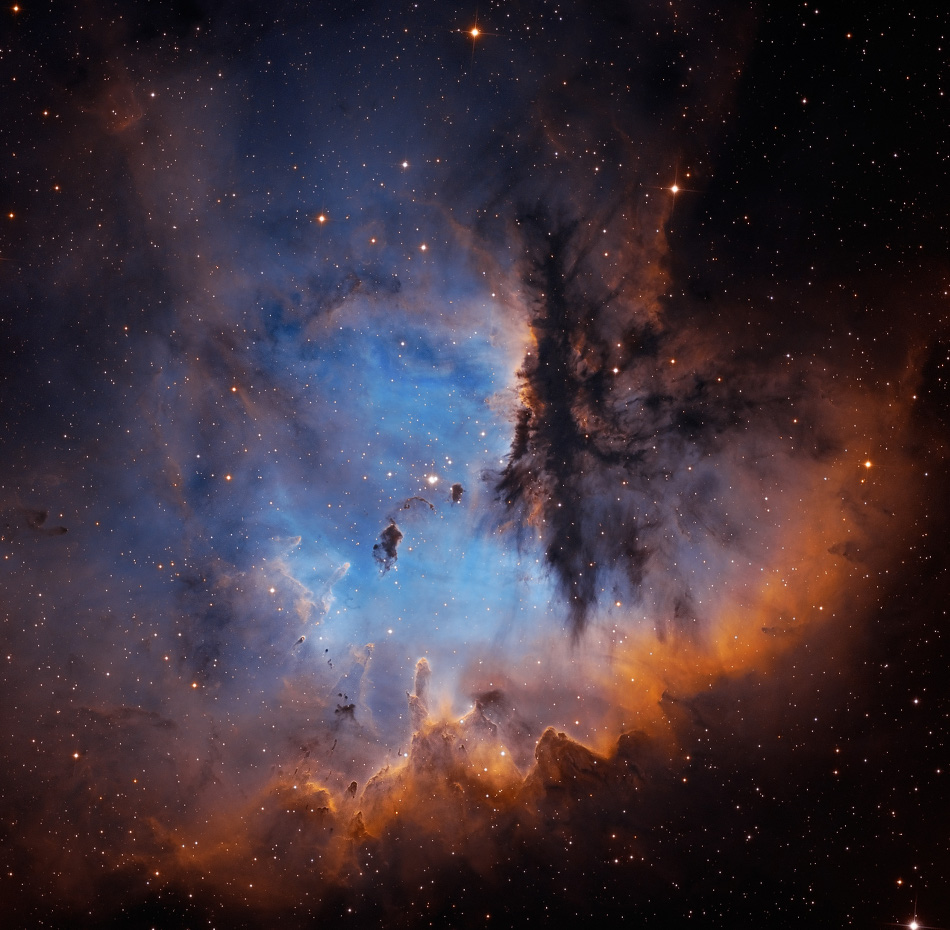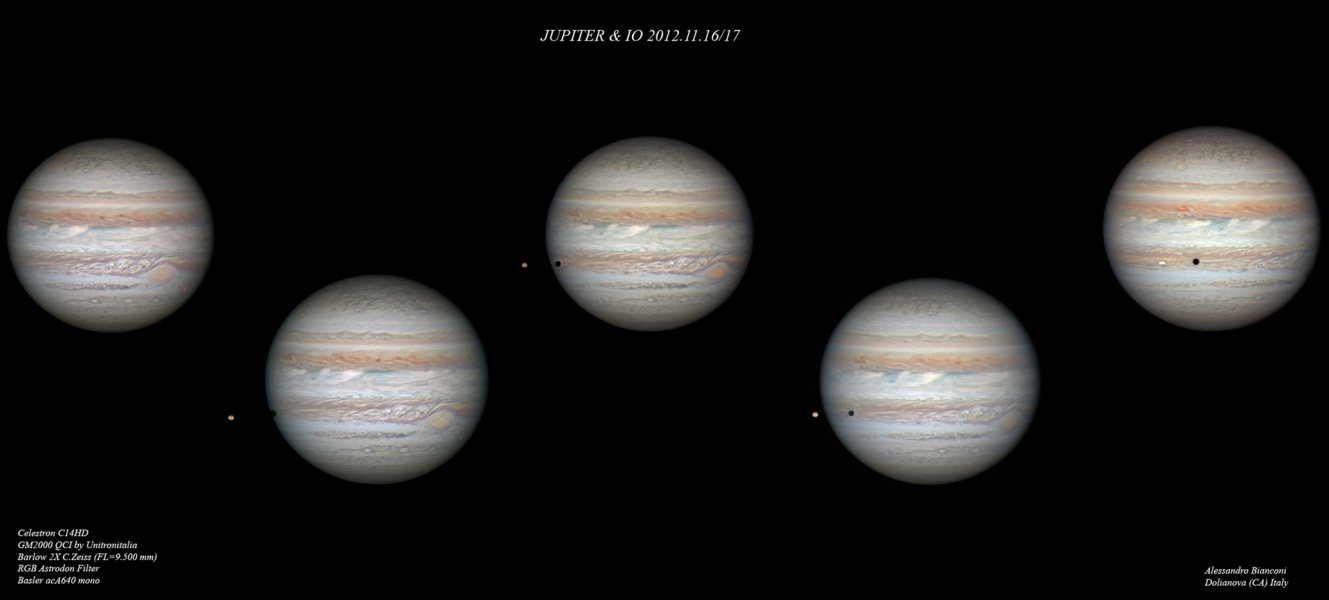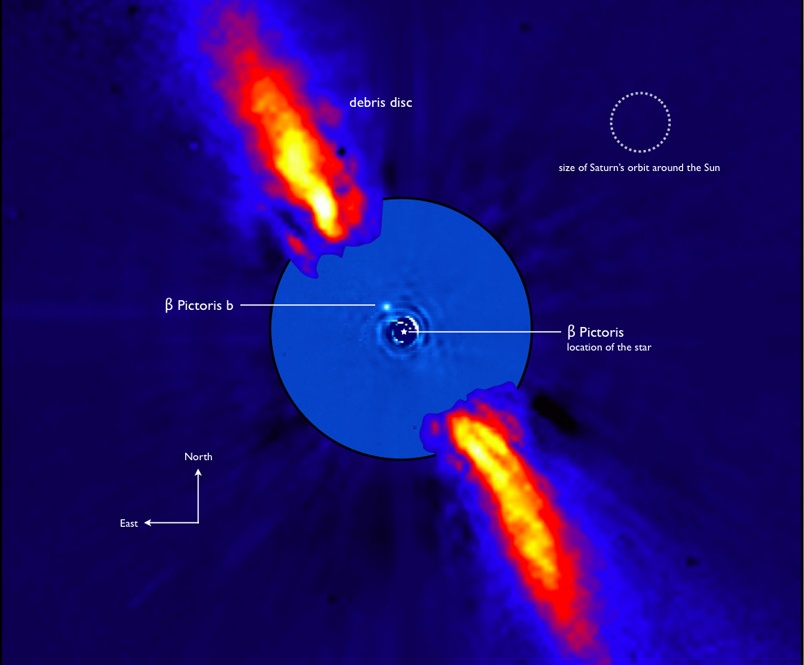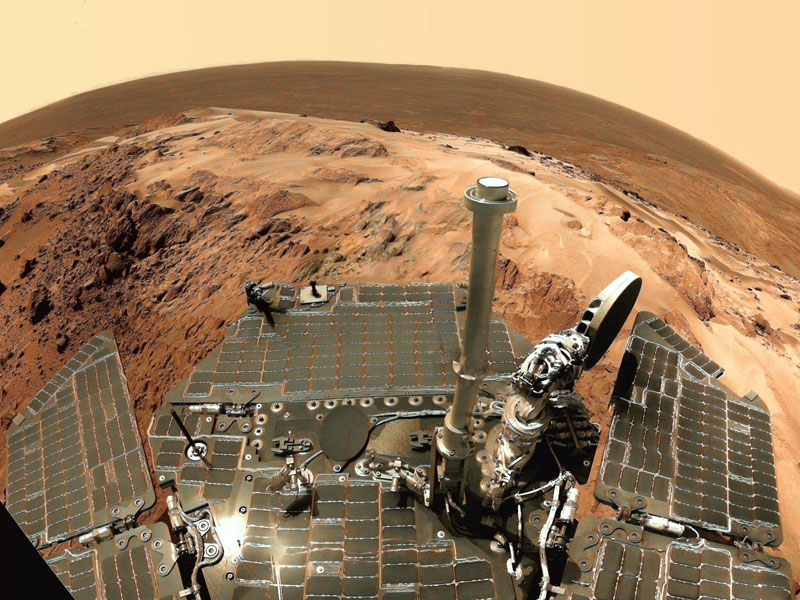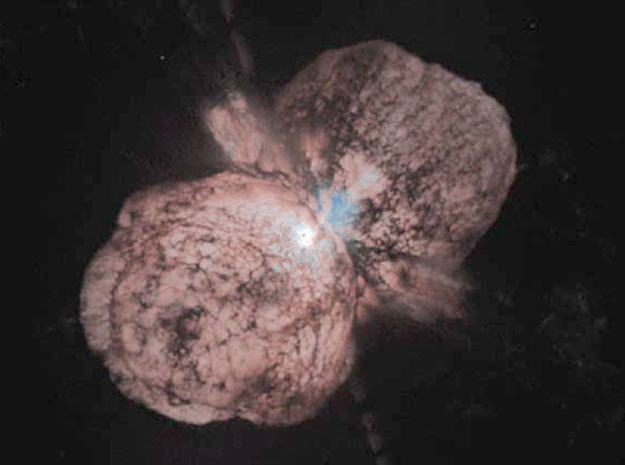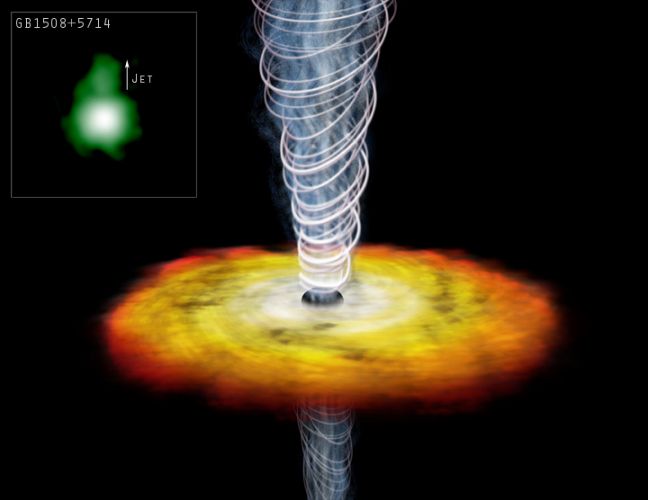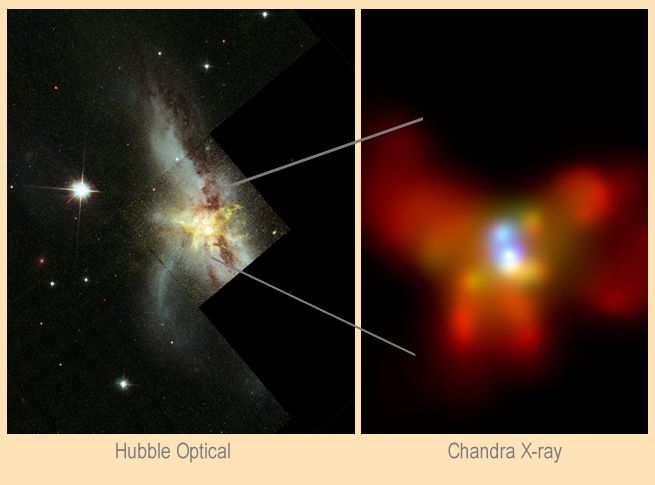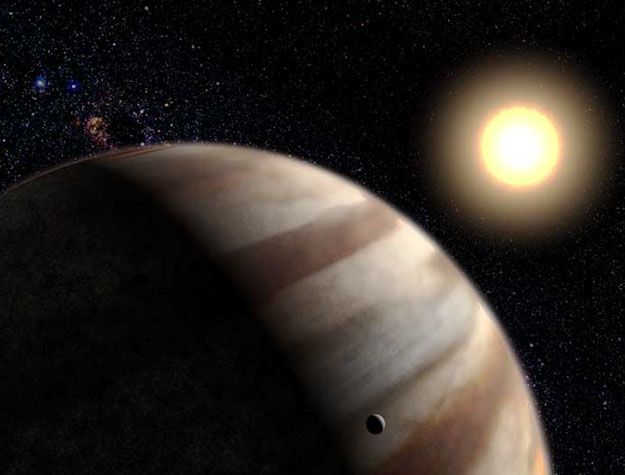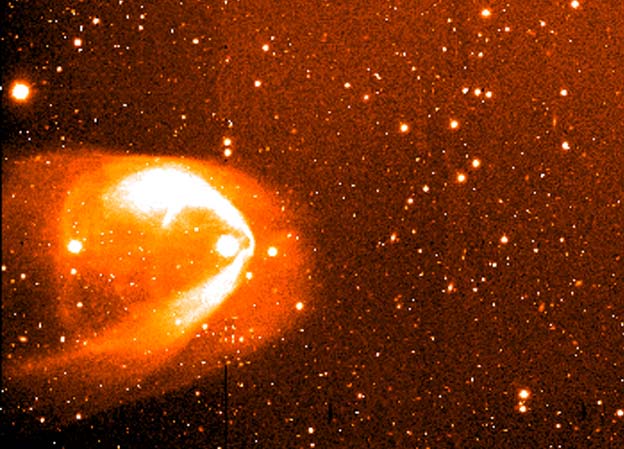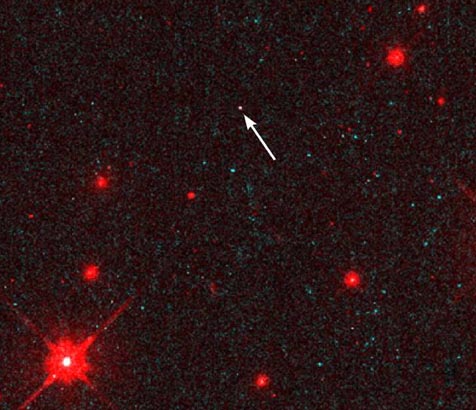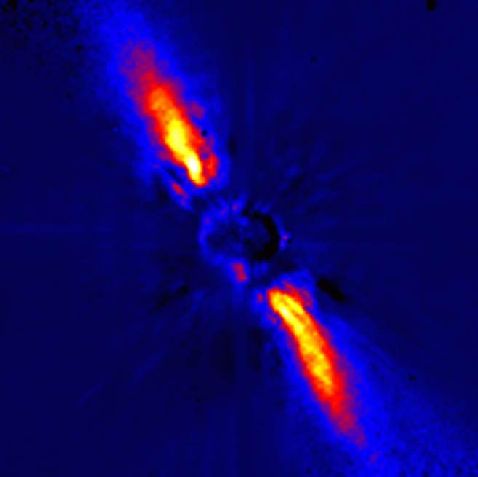| << Previous | Index | Next >> |
2014 Look through the cosmic cloud cataloged as NGC 281 and you might miss the stars of open cluster IC 1590. But, formed within the nebula, that cluster's young, massive stars ultimately power the pervasive nebular glow. The eye-catching shapes looming in this portrait of NGC 281 are sculpted columns and dense dust globules seen in silhouette, eroded by intense, energetic winds and radiation from the hot cluster stars. If they survive long enough, the dusty structures could also be sites of future star formation. Playfully called the Pacman Nebula because of its overall shape, NGC 281 is about 10,000 light-years away in the constellation Cassiopeia. This sharp composite image was made through narrow-band filters, combining emission from the nebula's hydrogen, sulfur, and oxygen atoms in green, red, and blue hues. It spans over 80 light-years at the estimated distance of NGC 281.
2013
2012 On December 3 (UT), Jupiter, the solar system's largest planet, will be at opposition, opposite the Sun in planet Earth's sky, shining brightly and rising as the Sun sets. That configuration results in Jupiter's almost annual closest approach to planet Earth. So, near opposition the gas giant offers earthbound telescopes stunning views of its stormy, banded atmosphere and large Galilean moons. For example, this sharp series was recorded on the night of November 16/17 from the island of Sardinia near Dolianova, Italy. North is up in the images that show off Jupiter's famous Great Red Spot, and planet girdling dark belts and light zones. Also seen in transit is Jupiter's volcanic moon Io, its round, dark shadow tracking across the Jovian cloud tops as the sequence progresses left to right.
2011 Asteroid Vesta is home to some of the most impressive cliffs in the Solar System. Pictured above near the image center is a very deep cliff running about 20 kilometers from top to bottom. The image was taken by the robotic Dawn spacecraft that began orbiting the 500-kilometer space rock earlier this year. The topography of the scarp and its surroundings indicates that huge landslides may have occurred down this slope. The scarp's origin remains unknown, but parts of the cliff face itself must be quite old as several craters have appeared in it since it was created. Dawn has now finished up its high altitude mapping survey and will spiral down to a lower altitude orbit to better explore the asteroid's gravitational field. During 2012, Dawn is scheduled to blast away from Vesta and begin a long journey to the only asteroid belt object known to be larger: Ceres.
2010 What's happening over the horizon? Although the scene may appear somehow supernatural, nothing more unusual is occurring than a setting Sun and some well placed clouds. Pictured above are anticrepuscular rays. To understand them, start by picturing common crepuscular rays that are seen any time that sunlight pours though scattered clouds. Now although sunlight indeed travels along straight lines, the projections of these lines onto the spherical sky are great circles. Therefore, the crepuscular rays from a setting (or rising) sun will appear to re-converge on the other side of the sky. At the anti-solar point 180 degrees around from the Sun, they are referred to as anticrepuscular rays. Pictured above is a particularly striking set of anticrepuscular rays photographed in 2001 from a moving car just outside of Boulder, Colorado, USA.
2009 In myth, Atlas holds up the heavens. But in this moonlit mountainscape, peaks of the Himalayan Annapurna Range appear to prop up the sky as seen from Ghandruk, Nepal. From left to right the three main peaks are Annapurna South (7,219 meters), Hiunchuli (6,441 metes), and Machapuchare (6,995 meters). Of course the mountains are moving not the stars, the Earth's rotation about its axis causing the concentric star trails recorded in the time exposure. Positioned above Annapurna South, the North Celestial Pole is easily identified as the point at the center of all the star trail arcs. The star Polaris, also known as the North Star, made the very short and bright arc closest to the North Celestial Pole.
2008 A mere 50 light-years away, young star Beta Pictoris became one of the most important stars in the sky in the early 1980s. Satellite and ground-based telescopic observations revealed the presence of a surrounding outer, dusty, debris disk and an inner clear zone about the size of our solar system -- strong evidence for the formation of planets. Now, infrared observations from European Southern Observatory telescopes incorporated in this composite offer a detection of a source in the clear zone that is most likely a giant planet orbiting Beta Pic. Designated Beta Pictoris b, the new source is more than 1,000 times fainter than the direct starlight that has been carefully subtracted from the image data. It is aligned with the disk at a projected distance that would place it near the orbit of Saturn if found in our solar system. Confirmation that the new source is a planet will come if future observations can demonstrate that the source moves in an orbit around the star. When confirmed, it will be the closest planet to its parent star directly imaged ... so far.
2007 Why did Comet Holmes brighten? The unexpectedly bright Comet 17P/Holmes continues to grace northern skies as a naked-eye addition to the constellation Perseus. Any northern sky enthusiast with a dark sky, a bright curiosity, and a recent sky map should still be able to locate the comet in a few minutes. What is seen, however, is primarily the sun-light reflecting dust coma. It surrounds an iceberg nucleus too small and too faint to discern. Clues to the nearly million-fold brightness increase are therefore being sought in dramatic images of the enigmatic comet's central regions taken earlier this month by the Hubble Space Telescope. One such Hubble image, shown above, indicates a still unresolved dense central dust cloud near the nucleus, surrounded by a more complex, anisotropic coma. The Hubble images do not show any obvious fragmentation of the nucleus, however, as was seen last year in Comet Schwassman-Wachmann 3. Observers around and above the world will continue to study this unusual addition to the night sky.
2006 Why is this galaxy so discombobulated? Usually, galaxies this topsy-turvy result from a recent collision with a neighboring galaxy. Spiral galaxy NGC 1313, however, appears to be alone. Brightly lit with new and blue massive stars, star formation appears so rampant in NGC 1313 that it has been labeled a starburst galaxy. Strange features of NGC 1313 include that its spiral arms are lopsided and its rotational axis is not at the center of the nuclear bar. Pictured above, NGC 1313 spans about 50,000 light years and lies only about 15 million light years away toward the constellation of Reticulum. Continued numerical modeling of galaxies like NGC 1313 might shed some light on its unusual nature.
2005
2004 Eta Carinae may be about to explode. But no one knows when - it may be next year, it may be one million years from now. Eta Carinae's mass - about 100 times greater than our Sun - makes it an excellent candidate for a full blown supernova. Historical records do show that about 150 years ago Eta Carinae underwent an unusual outburst that made it one of the brightest stars in the southern sky. Eta Carinae, in the Keyhole Nebula, is the only star currently thought to emit natural LASER light. This image, taken in 1996, resulted from sophisticated image-processing procedures designed to bring out new details in the unusual nebula that surrounds this rogue star. Now clearly visible are two distinct lobes, a hot central region, and strange radial streaks. The lobes are filled with lanes of gas and dust which absorb the blue and ultraviolet light emitted near the center. The streaks remain unexplained. Will these clues tell us how the nebula was formed? Will they better indicate when Eta Carinae will explode?
2003 A false-color x-ray image inset at upper left reveals emission from a cosmic jet of high-energy particles, 100,000 light-years in length, emerging from quasar GB1508+5714. An estimated 12 billion (12,000,000,000) light-years away, this appears to be the most distant energetic jet in the known Universe. Astrophysical jets of many sizes seem to be produced in a range of environments where significant accretion, or infalling matter is thought to arrange itself in a disk, from contracting star-forming clouds to supermassive black holes in active galactic nuclei. Here, as depicted in the illustration, the accretion disk is thought to surround a supermassive black hole, accelerating particles to near the speed of light in two jets at right angles to the disk itself. In the case of this quasar, the jet tilted towards us is visible in x-rays as the particles collide with low energy photons from the cosmic background radiation. The collisions boost the photons to higher x-ray energies and scatter some of them in our direction.
2002
2001 By directly detecting the atmosphere of a planet outside our Solar System, humanity has taken another small step toward finding extraterrestrial life. The unexpected detection by David Charbonneau (Caltech) and associates came from Hubble Space Telescope observations of Sun-like star HD 209458. As an orbiting planet crossed between that star and the Earth, sodium in the planet's atmosphere absorbed starlight at very specific colors. The planet, originally discovered two years ago, has about 70 percent the mass of Jupiter but orbits very close in. A long-term goal of this type of research is the detection of planetary biomarkers that would indicate life, such as oxygen, water, or methane.
2000 BZ Cam is a binary star system that is not well understood. In most cataclysmic variables, matter from a normal star accumulates on the surface of the companion white dwarf star, eventually causing a nova-like flare as the material becomes hot enough to ignite nuclear fusion. In BZ Cam, however, light appears to flicker unpredictably, and an unusually large wind of particles is being expelled. Pictured above, BZ Cam's wind creates a large bow-shock as the system moves through surrounding interstellar gas. BZ Cam lies about 2500 light-years away toward the constellation of Camelopardalis.
1999 If the thick clouds covering Venus were removed, how would the surface appear? Using an imaging radar technique, the Magellan spacecraft was able to lift the veil from the Face of Venus and produce this spectacular high resolution image of the planet's surface. Red, in this false-color map, represents mountains, while blue represents valleys. This 3-kilometer resolution map is a composite of Magellan images compiled between 1990 and 1994. Gaps were filled in by the Earth-based Arecibo Radio Telescope. The large yellow/red area in the north is Ishtar Terra featuring Maxwell Montes, the largest mountain on Venus. The large highland regions are analogous to continents on Earth. Scientists are particularly interested in exploring the geology of Venus because of its similarity to Earth.
1998 How massive can a star get without imploding into a black hole? These limits are being tested by the discovery of a lone neutron star in space. Observations by the Hubble Space Telescope have been combined with previous observations by the X-ray ROSAT observatory and ultraviolet EUVE observatory for the isolated star at the location of the arrow. Astronomers are able to directly infer the star's size from measurements of its unblended brightness, temperature, and an upper limit on the distance. Assuming that the object is a neutron star of typical mass, some previous theories of neutron star structure would have predicted an implosion that would have created a black hole. That this neutron star even exists therefore allows a window to the extreme conditions that exist in the interiors of neutron stars.
1997 In the early 1980s, Beta Pictoris became one of the most important stars in the sky. Satellite and ground-based telescopic observations revealed the presence of a surrounding outer disk of material and an inner "clear" zone about the size of our solar system - strong evidence for the formation of planets. Beta Pictoris is 50 light years away and any orbiting planets are too small and faint to image at that distance. But evidence continues to mount that this star indeed has comet-like bodies in the disk and a Jupiter-sized planet orbiting within the central zone. Shown here in false color, this recent, highly detailed picture was obtained at the European Southern Observatory by blocking the overwhelming direct starlight and imaging the near-infrared light from the disk. The disk's warped bright inner region is indirect evidence for an orbiting planet.
1996 In a cartwheel-shaped galaxy far, far away, huge comet-shaped clouds of gas have been discovered racing through the nucleus at about 700,000 miles per hour. The aptly named Cartwheel Galaxy is actually about 500 million light years distant, its suggestive shape created by a head-on collision with a smaller galaxy. Researchers studying this disrupted galaxy using Hubble Space Telescope data recently discovered immense gaseous structures with heads a few hundred light years across and tails thousands of light years long. The fast moving dense gas clouds appear as blue comet-like shapes, mostly along the upper edge of the nucleus, in this false color close-up of the Cartwheel's central region. Their shape, like a boat's bow wave, was probably created by the dense clouds moving through less dense material.
1995 In 1994, the space probe Clementine spent 70 days in lunar orbit mapping the Moon's surface. Shown above is a dramatically detailed composite view centered on the Moon's South Pole constructed from 1500 Clementine images. The top half shows the part of the Moon which faces the Earth while the bottom half is the lunar Farside. The images reveal a major depression very near the South Pole itself, probably caused by the impact of a comet or asteroid. The shadow region near the impact site is extensive and may be permanent - creating an area cold enough to trap water of cometary origin as ice.
| << Previous | Index | Next >> |
